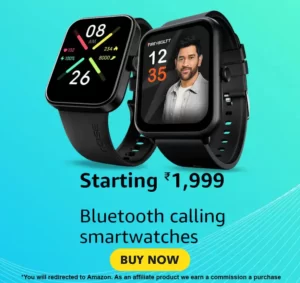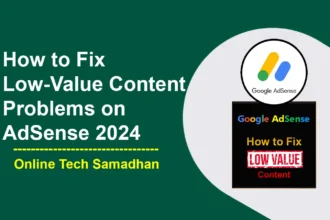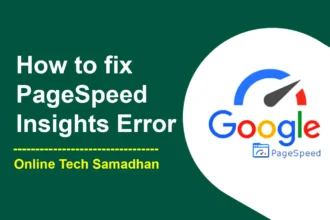Maximizing Revenue Potential: A Comparison of Google AdX vs Google AdSense
Online advertising has become an essential part of the digital world, and Google offers two popular platforms for publishers to monetize their websites: Google AdX and Google AdSense. While both platforms Google AdX vs Google AdSense are owned by Google, they have distinct differences in terms of eligibility criteria, revenue potential, level of control, and ad formats.
Google AdX is a more advanced platform designed for larger publishers who have high traffic volume and want more control over their ad inventory. It offers higher revenue potential and supports a wider range of ad formats.
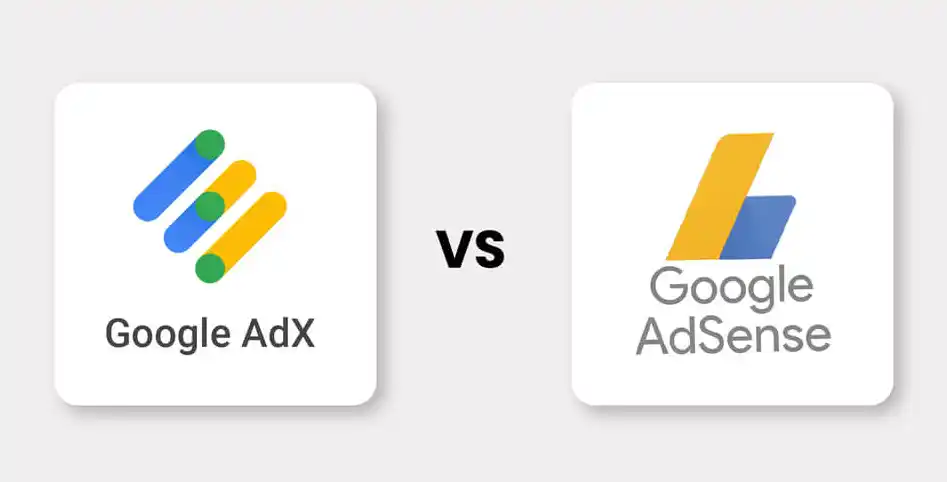
Google AdSense, on the other hand, is a simpler platform that’s open to most publishers, regardless of their traffic volume or content. It provides less control over ad inventory but is easier to set up and manage. Ultimately, the choice between Google AdX and AdSense depends on various factors, including website size, revenue goals, and level of control.
You May Love To Read
What Is Google AdX?
Google AdX, also known as Google Ad Exchange, is a programmatic advertising platform that allows publishers to sell their ad inventory to a wide range of advertisers. It is a real-time marketplace where publishers can maximize their ad revenue by connecting with premium advertisers and accessing a larger demand pool. Google AdX operates on a CPM (Cost Per Thousand Impressions) model, where advertisers bid to display their ads on publishers’ websites.
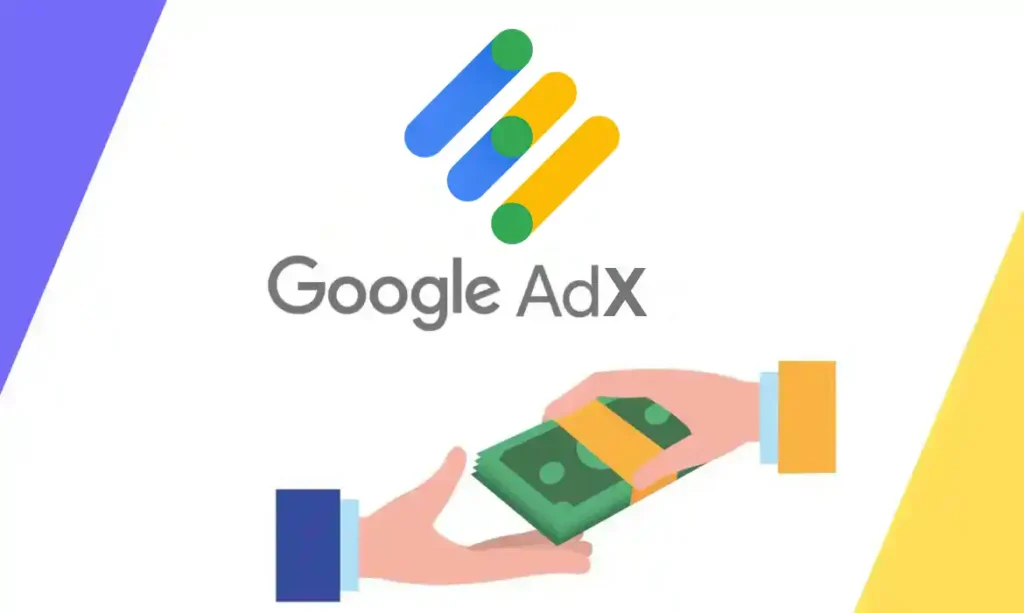
How Does Google AdX Work?
Google AdX works by leveraging real-time bidding (RTB) to match advertisers’ bids with publishers’ ad inventory. Publishers integrate AdX into their websites, and when a user visits a page, AdX generates an ad request. Advertisers then bid on these ad requests in real time, and the highest bidder’s ad is displayed on the website. This process happens within milliseconds, ensuring that the highest-paying ad is shown to maximize revenue for the publisher.
Let’s Explore how Google AdX works:
- Publishers integrate AdX into their websites by adding AdX tags to their pages.
- When a user visits a page on the publisher’s website, AdX generates an ad request that includes information about the user, the website, and the ad placement.
- Advertisers using the Authorized Buyers platform receive the ad request and can choose to bid on the ad placement.
- Advertisers can set bids based on various factors, such as the audience, ad placement, and time of day. The highest bidder’s ad is selected to be displayed on the website.
- The selected ad is then served to the user in the ad placement on the website.
- If the user interacts with the ad, such as by clicking on it, the publisher earns revenue based on the bid amount.
- The process repeats for each ad placement on the publisher’s website, with AdX generating ad requests and advertisers bidding in real time to display their ads.
What Is Google AdSense?
Google AdSense is another advertising platform offered by Google. It is designed for smaller publishers who want an easy way to monetize their websites. AdSense allows publishers to display Google ads on their websites and earn money when users interact with these ads. Unlike AdX, AdSense is not a real-time bidding platform. Instead, it uses contextual targeting to display relevant ads based on the content of the website.
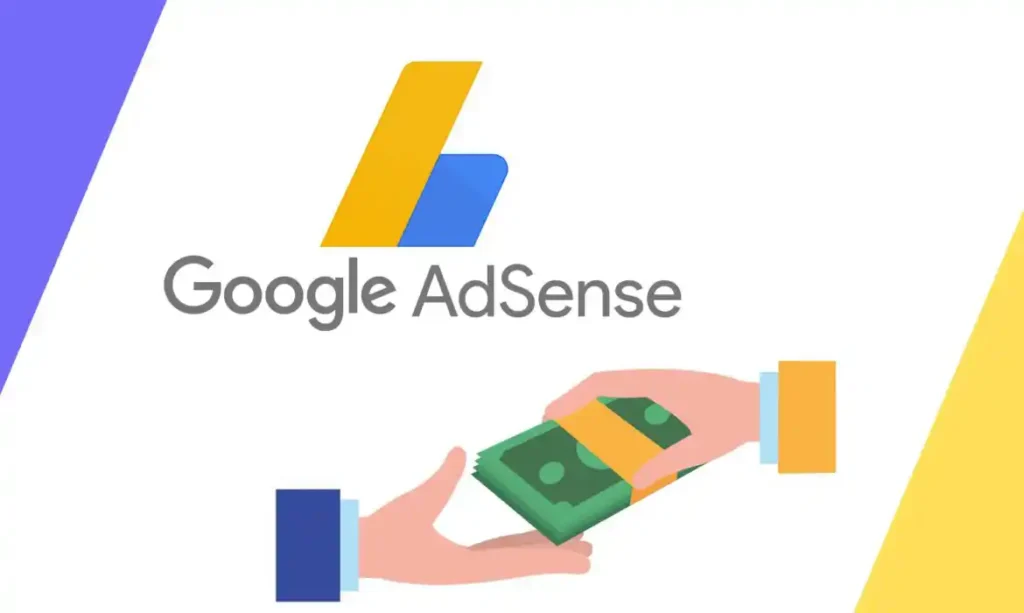
How Does Google AdSense Work?
Google AdSense works by analyzing the content of a website and displaying ads that are relevant to that content. Publishers sign up for AdSense and place ad codes on their websites. When a user visits a page, AdSense analyzes the content and displays ads that are likely to be of interest to the user. Publishers earn money when users click on these ads or when they view them (impressions).
Let’s Explore how Google AdSense works:
- Publishers sign up for Google AdSense by creating an account and providing details about their website(s).
- Once approved, publishers receive an AdSense code snippet to place on their website. This code is typically inserted into the HTML of the website or added through a website builder or content management system.
- When a user visits a page on the publisher’s website, the AdSense code generates an ad request.
- AdSense analyzes the content of the webpage, considering factors such as keywords, user demographics, and browsing history, to determine the most relevant ads.
- AdSense then serves targeted ads from its pool of advertisers to the publisher’s website. These ads can be in various formats, such as text, image, or video.
- The ads are displayed in designated ad slots on the publisher’s website, blending in with the overall design and layout.
- Users interact with the ads by either clicking on them or viewing them (impressions).
- Publishers earn revenue when users click on the ads (Cost Per Click or CPC) or when the ads are viewed (Cost Per Thousand Impressions or CPM).
- The revenue earned by the publisher is shared between Google and the publisher, with the exact revenue share percentage varying based on factors such as ad type, advertiser, and geographic location.
- Publishers can track their ad performance, earnings, and other metrics through the AdSense dashboard, which provides insights into clicks, impressions, click-through rates, and revenue.
- AdSense handles the billing and payment process, with payments typically made every month.
Google AdX vs Google AdSense: What Are the Key Differences?
- Advertiser Pool: AdX has a larger pool of premium advertisers, including major brands and agencies. Conversely, AdSense may display ads from a wider range of advertisers, including smaller businesses and individual advertisers.
- Revenue Potential: AdX generally offers higher revenue potential because it connects publishers with premium advertisers willing to pay more for ad space. AdSense, while still profitable, may generate lower revenue as it caters to a broader range of advertisers.
- Control and Customization: AdX provides more control and customization options for publishers. They can set minimum CPMs, block specific ads or categories, and have more control over ad placements. AdSense offers less control but is easier to set up and manage.
There are some of the more vital aspects we should notice
| Aspect | Google AdX | Google AdSense |
|---|---|---|
| Platform | Ad exchange for multiple buyer bidding | Ad network for Google-managed ads |
| Bidding Process | Real-time bidding (RTB) | Fixed CPM or CPC bidding by Google |
| Control | More control over formats, pricing, etc. | Limited control, hands-off approach |
| Advertisers | Premium brands and agencies | Primarily Google Ads advertisers |
| Minimum Requirements | High traffic volume, technical expertise | Moderate traffic, limited technical knowledge |
| Cost | No direct setup cost, potential charges | No setup cost, revenue share (68%) |
| Payment | Net 30 terms, higher traffic for payout | $10 threshold, faster access for smaller sites |
| Suitability | Large publishers with premium inventory | Smaller websites seeking simplicity |
Google AdX vs Google AdSense Eligibility Check
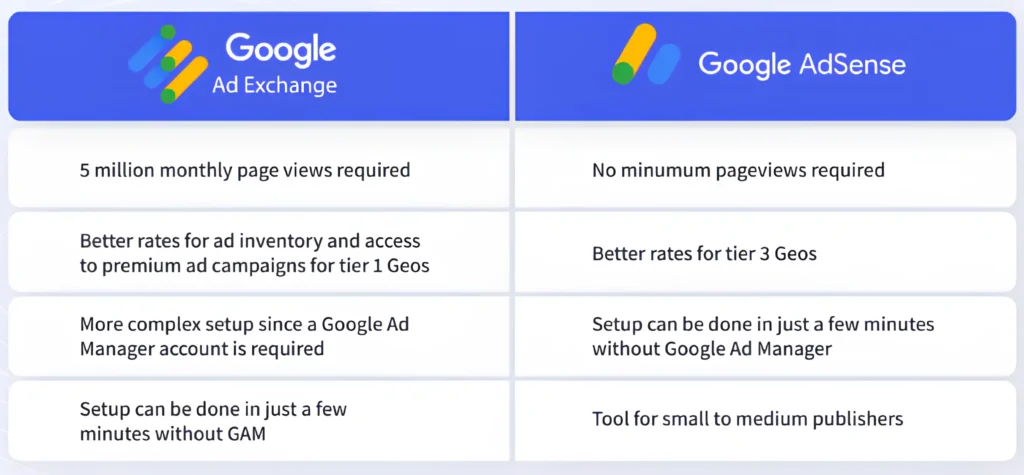
What Is Google Ad Manager?
Google Ad Manager is an ad management platform that allows publishers to manage their ad inventory across multiple ad networks, including AdX and AdSense. It provides tools for ad targeting, ad delivery, and ad optimization.
You May Love To Read
How Authorized Buyers Work With Google Ad Manager:
Authorized Buyers, previously known as DoubleClick Ad Exchange, is a program within Google Ad Manager that allows advertisers to bid on ad inventory from publishers. Advertisers can access the Authorized Buyers marketplace to buy ad space from publishers using real-time bidding.
Let’s Explore how Authorized Buyers works with Google Ad Manager:
- Publishers integrate Google Ad Manager into their websites and make their ad inventory available for sale through the Authorized Buyers marketplace.
- Advertisers, using the Authorized Buyers platform, create and manage their advertising campaigns, setting parameters such as targeting options, budget, and bid strategies.
- When a user visits a publisher’s website, an ad request is generated through Google Ad Manager.
- The ad request is sent to the Authorized Buyers marketplace, where advertisers have the opportunity to bid on the available ad inventory in real time.
- Advertisers determine their bids based on factors such as audience targeting, ad placement, and campaign objectives.
- The highest bidder’s ad is selected to be displayed on the publisher’s website.
- The selected ad is then served to the user in the designated ad placement on the website.
- If the user interacts with the ad, such as by clicking on it, the advertiser is charged for that interaction, and the publisher earns revenue from the ad click.
- The process repeats for each ad placement on the publisher’s website, with ad requests being sent to the Authorized Buyers marketplace, and advertisers bidding in real-time to display their ads.
- Google Ad Manager manages the entire process, including ad serving, reporting, and billing.
- Publishers can access reports and insights through Google Ad Manager to track the performance of their ad inventory and revenue generated.
How to Get Started With Google AdX?
Getting started with Google AdX can seem complex, but it doesn’t have to be! Here’s a simplified breakdown of the key steps involved:
1. Check the Eligibility:
The first step to getting started with AdX is to check if you meet the requirements. AdX has stricter requirements than AdSense, so ideally, your website should have high traffic volume (Minimum Ten thousand of page views per day) and unique content. You’ll also need basic technical knowledge to manage ad tags and integrate with platforms like Google Ad Manager (GAM).
2. Explore your options:
There are a couple of options for accessing AdX. If you already use Google Ad Manager, your Account Manager might invite you to AdX directly. Otherwise, you can consider partnered resellers (Google Publishing Partners) who can help you access AdX even if you don’t meet the direct requirements.
3. Get your site certified:
Before you can start using AdX, your site needs to be certified. This involves compliance checks to ensure your site complies with Google’s content and quality guidelines. Tools like the Google Search Console can help you identify and fix any issues. Your traffic will also be audited to ensure legitimacy and prevent fraud.
4. Set up your account:
Once your site is certified, you can create an AdX account. This involves filling out an application and submitting it for approval. Once approved, you’ll need to follow the instructions to set up your AdX account. If you plan to use GAM for ad management, connect your AdX account for seamless integration.
5. Understand the basics:
It’s important to understand the basics of AdX before you start using it. This includes defining which ad units on your website you want to monetize through AdX, learning about different pricing models like CPM (cost per thousand impressions) and CPC (cost per click), and deciding how you want to target ads based on audience, interests, and demographics.
6. Start small and experiment:
Once you have your account set up and understand the basics of AdX, it’s time to start experimenting. Start small and optimize your setup by monitoring your performance and adjusting your targeting, pricing, and ad formats for better results. Use Google’s resources, documentation, and forums to learn and troubleshoot any issues.
How to Get Started With Google AdSense:
Getting started with AdSense is relatively easier. Publishers can sign up for an AdSense account, create ad units, and place the ad code on their websites. AdSense provides step-by-step guidance on how to set up and integrate ads into websites.
Google AdX vs AdSense Revenue: Which Generates Greater Returns?
The revenue potential of Google AdX is generally higher than that of AdSense. AdX connects publishers with premium advertisers, resulting in higher bids and potentially higher revenue. However, AdSense can still be profitable, especially for smaller publishers or those with niche audiences.
AdX or AdSense: Which Should I Choose?
If you are confused about choosing between AdX or AdSense here are the the key aspects to consider when choosing between AdX and AdSense:
- Website Size:
AdX is more suitable for larger publishers with high traffic volume (thousands of page views per day). AdSense is a good choice for smaller publishers or those with lower traffic volume. - Revenue Goals:
AdX offers higher revenue potential than AdSense, but it requires more effort and resources to manage. AdSense, on the other hand, is easier to set up and manage, but may not generate as much revenue as AdX. - Level of Control:
AdX provides more control over ad inventory and ad management, allowing publishers to set their pricing, target specific audiences, and manage their ad inventory. AdSense, on the other hand, provides less control over ad inventory and is more automated. - Eligibility Criteria:
AdX has stricter eligibility criteria than AdSense. Publishers need to meet specific traffic and content requirements and undergo a certification process before they can start using AdX. AdSense, on the other hand, is open to most publishers, regardless of their traffic volume or content. - Ad Formats:
AdX supports a wider range of ad formats, including video ads and native ads, which can generate higher revenue. AdSense, on the other hand, is more limited in terms of ad formats but offers a simpler setup process.
Choosing between AdX and AdSense depends on various factors, including the size of your website, the level of control you want, and your revenue goals. AdX is more suitable for larger publishers who can meet the eligibility criteria and want more control over their ad inventory. AdSense is a good choice for smaller publishers or those who prefer a simpler setup and management process.
Conclusion on Google AdX vs Google AdSense
Google AdX and Google AdSense are two distinct platforms offered by Google for online advertising. AdX is designed for larger publishers with high traffic volume, offering greater control over ad inventory and supporting a wider range of ad formats. It provides the potential for higher revenue generation. On the other hand, AdSense is a simpler platform suitable for smaller publishers or those new to online advertising. It is easier to set up and manage, although it may have less control over ad inventory.
When deciding between AdX and AdSense, it is important to consider factors such as website size, revenue goals, and desired level of control. AdX is ideal for larger publishers aiming to maximize earnings and have more control over their ad inventory. AdSense, on the other hand, is a convenient option for smaller publishers or those seeking simplicity in monetizing their websites. Ultimately, the choice depends on the specific needs and goals of the publisher, with both platforms offering opportunities to generate revenue through online advertising.
FAQs
What is Google AdX called now?
Google AdX is now known as Google Ad Manager. This platform offers similar features and capabilities as AdX, including advanced ad serving and revenue optimization tools.
Is Google Ads Same as Google AdSense?
No, Google Ads and Google AdSense are two different platforms offered by Google for online advertising. Google Ads is a platform for creating and running online advertising campaigns, while Google AdSense is a platform for website publishers to monetize their websites through display advertising.
Is there anything better than Google AdSense?
There are several alternative ad networks and platforms that offer different features and revenue models compared to Google AdSense. Some of the popular options include Media.net, Amazon Associates, and PropellerAds, among others. The best platform depends on your specific needs and goals.
What is the difference between Google AdX and Google Ad Manager?
Google Ad Manager is the new name for Google AdX, and it offers similar features and capabilities as AdX. However, Ad Manager is a more comprehensive platform that includes ad serving, programmatic buying, and revenue optimization tools. AdX, on the other hand, only offers advanced ad serving and revenue optimization tools.
Which platform is better for maximizing revenue?
Google AdX has the potential for higher revenue generation compared to Google AdSense. It offers advanced features and more control over ad inventory, making it an ideal choice for larger publishers looking to maximize their earnings.
Which platform is easier to use?
Google AdSense is easier to set up and manage compared to Google AdX. It is designed to be user-friendly and convenient, making it a suitable option for smaller publishers or those seeking simplicity in monetizing their websites.
Can anyone use Google AdX and Google AdSense?
While Google AdX is more selective and requires higher traffic volume, Google AdSense is open to most publishers, regardless of their website size or traffic volume. AdSense provides an opportunity for smaller publishers to monetize their websites effectively.







